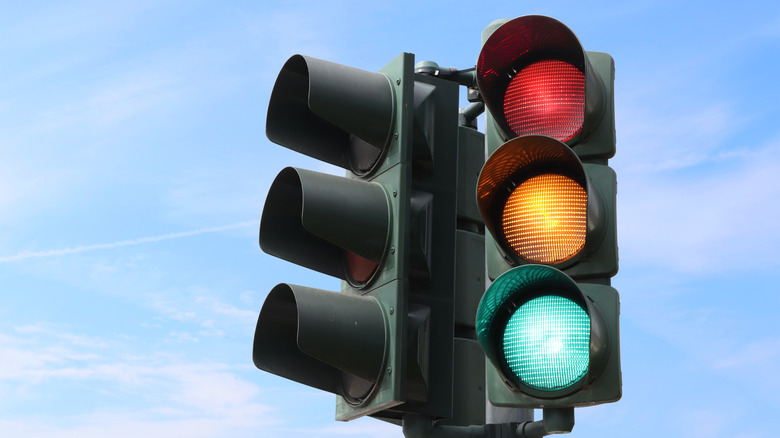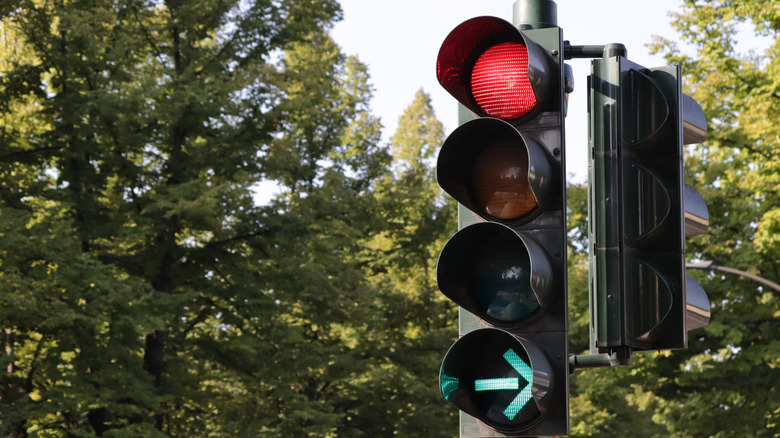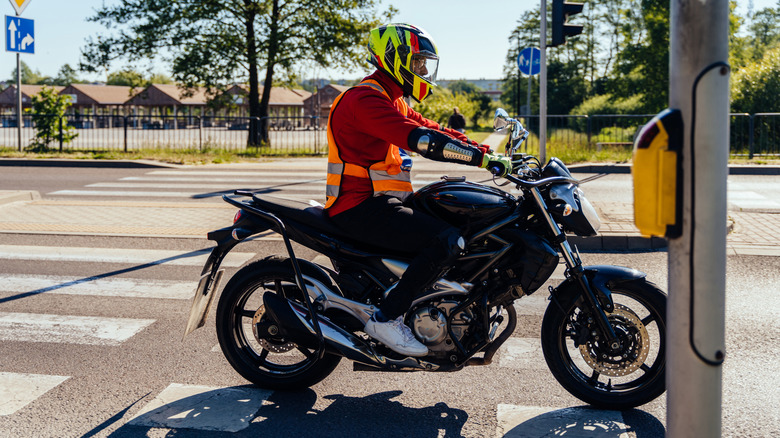Can You Run A Red Light That Just Won't Turn Green?
It seems to be a universal experience for drivers that the more anxious you are to get to your destination (or the later you're running), the more likely those lights are to be red. Typically, they'll cycle in just a moment, and you'll be on your way. Traffic lights' cameras are partially there to help with that. There's no denying the crucial role that lights play in road safety; running a red light is often a very dangerous and costly mistake to make. So what happens if a given traffic light just refuses to turn green?
The short answer is obviously no, you cannot just run a red light. If the light is taking a long time to change, there's no excuse for simply getting impatient and proceeding onward. Officer Cody Tapley of the Sacramento Police Department explained to The Sacramento Bee that "the only exemption for running a red light is when directed by a law enforcement officer or authorized traffic director." However, though it seems cut and dried, there's much more to the issue than that. For instance, it may not be functioning correctly. In instances such as this, it's vital that a motorist knows what they can and can't do.
Some potential actions to take
The critical thing is to understand what you can and can't do for the State you're in. Pennsylvania, for instance, boasts a law known as Ride on Red, as of September 2016. As the Pennsylvania Department of Transportation explained on social media, "If the traffic signal's vehicle-detection system fails to recognize a vehicle (car, bicycle, motorcycle or otherwise), the vehicle may proceed with caution as if it were a stop sign." It's a similar case in the UK's Highway Code, Rule 176 of which states that drivers should "treat the situation as you would an unmarked junction and proceed with great care." Pennsylvanians don't have free rein to bypass any red light they please: If it's functioning normally as you approach, the standard procedure applies instead. Drivers also won't have much recourse if they are stuck in front of a red light that doesn't change.
One vital step, if it seems clear that the light isn't changing, is to call 911. Verifying that you have spoken with 911 after passing a light that refuses to change can help your case if the police then stop you. Jermaine Walker of the Washington State Patrol explained to The Bellingham Herald that, should the light still be inoperable after informing the authorities and continuing to wait, "we recommend treating the intersection as if it were controlled by a flashing red light ... come to a complete stop, yield to other traffic, and proceed with caution when it is safe to do so."
Motorcycles can be unique cases
There is one unique exception in some of these cases. Traffic lights don't always detect smaller vehicles like motorcycles and bicycles, and they might find themselves truly stuck. A dead red law means that they have the right to proceed after a certain amount of time has passed. What you absolutely can't do, though, is simply roar through. All these laws do is allow the biker to take appropriate actions as governed by local laws.
There are different types of red light laws, too. Arkansas statute 27-51-1803, for instance, states that bikers need to stop completely when coming to a red light that is not changing and can proceed to an intersection after yielding the right of way as needed. Meanwhile, Indiana statute 9-21-3-7(b)(3)(D) declares that a red light must be approached as though it were a stop sign. Additionally, two minutes or more must be allowed before the rider proceeds to the intersection. In other states, including Missouri and Minnesota, a light that isn't working properly can be bypassed after what is deemed a "reasonable period of time". Running a red light is typically prohibited, but depending on the circumstances and where you're driving, you may be able to pass through if you take appropriate precautions. Just hope you never have to deal with the most infuriating traffic light in U.S. history.


